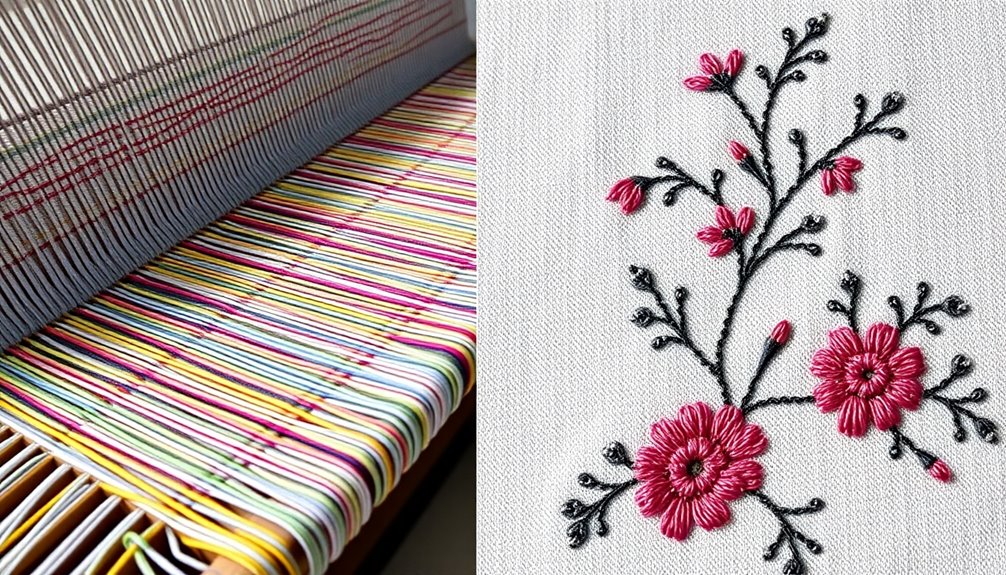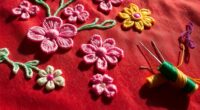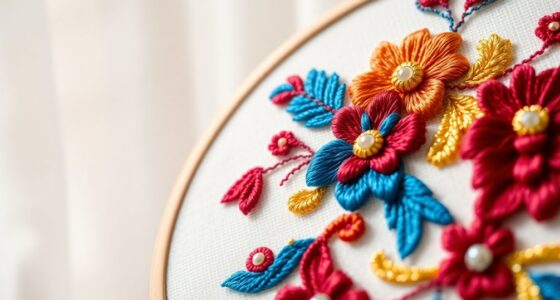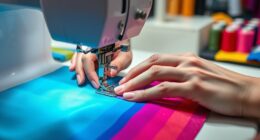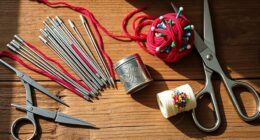Weaving and embroidery serve different purposes in textile creation. When you weave, you interlace threads on a loom to create strong fabrics like clothing and upholstery. In contrast, embroidery decorates these fabrics with artistic stitches, enhancing their visual appeal. Weaving focuses on structural integrity, while embroidery emphasizes artistic detail. Both techniques showcase creativity, and understanding their differences can elevate your textile knowledge. Explore further to uncover more about their unique processes and applications!
Key Takeaways
- Weaving creates fabric by interlacing warp and weft threads, while embroidery decorates existing fabric with stitches and embellishments.
- Weaving utilizes looms and techniques like plain, satin, and twill weaves for structural integrity, whereas embroidery uses hand or machine techniques for decorative purposes.
- The primary purpose of weaving is to produce strong, functional textiles, while embroidery enhances the aesthetic appeal of garments and accessories.
- Common materials for weaving include cotton and silk, while embroidery threads can be rayon, metallic, or cotton, often with added embellishments.
- Weaving is essential for creating home textiles and functional fabrics, while embroidery is popular for custom gifts and promotional materials.
Difference Between Weaving and Embroidery
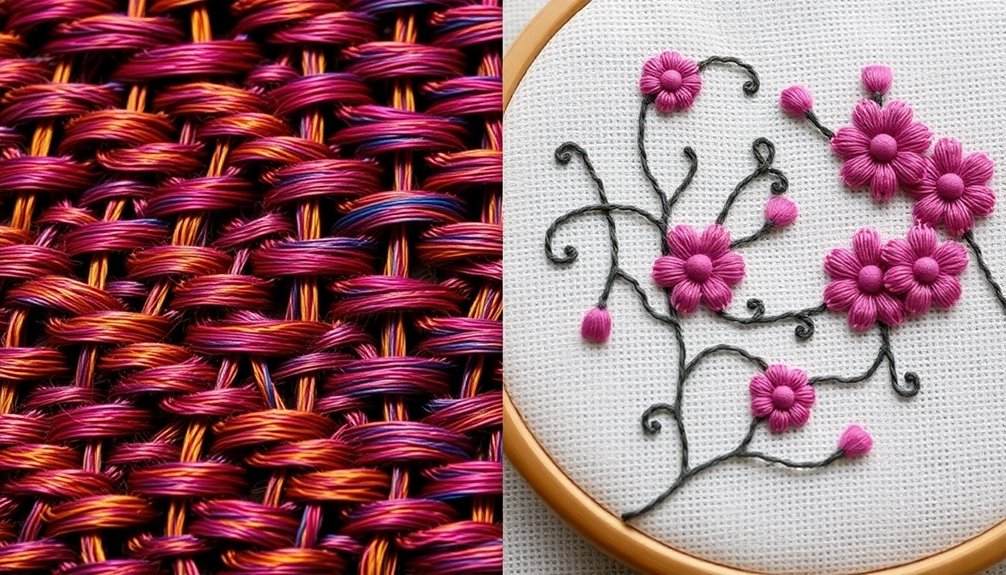
While both weaving and embroidery involve the use of thread, they serve distinct purposes in fabric creation and decoration.
Weaving is the process of interlacing warp and weft threads to create textile structures, resulting in various fabric types. Techniques like plain weave and satin weave establish the fabric's foundation.
In contrast, embroidery enhances existing fabric with intricate designs using stitching techniques such as cross-stitch and satin stitch. This process transforms plain cloth into decorative items, adding patterns and embellishments.
Understanding these differences is essential when selecting the appropriate method for your project, whether you're focused on functional fabric creation through weaving or aiming for decorative enhancement via embroidery.
Each technique offers unique advantages based on your design goals.
What Is Weaving?
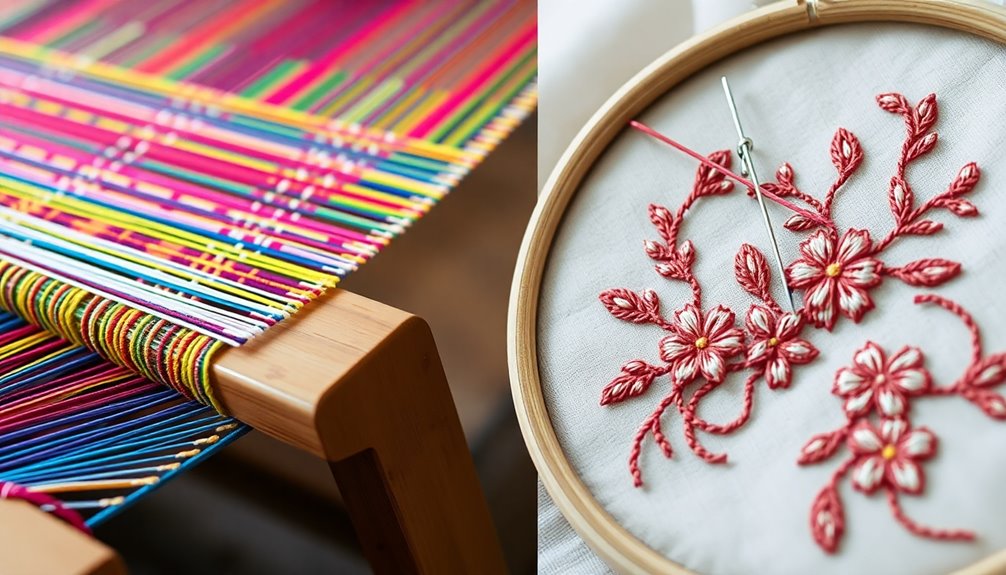
Weaving is a fundamental technique in fabric creation that involves interlacing two sets of yarns: the warp and the weft. This process allows you to create beautiful fabric from scratch using various techniques.
- Warp and weft threads are interlaced at right angles.
- Natural fibers like cotton and silk are common materials used.
- Techniques used include plain weave, twill weave, and satin weave.
- Weaving can be done on both handlooms and mechanized machines.
The Weaving Process
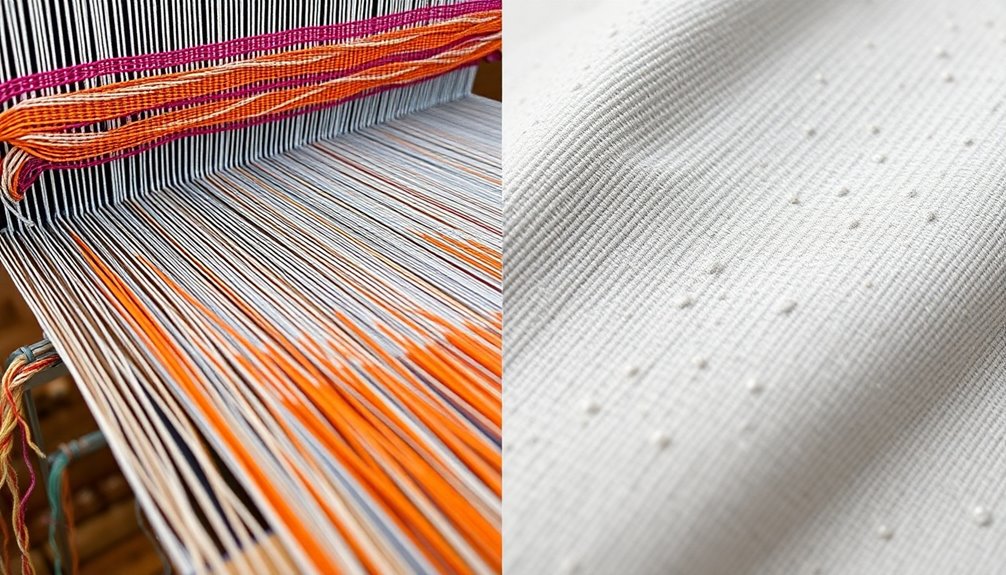
The weaving process is a fascinating interplay of creativity and technique, transforming threads into fabric through a series of precise actions on a loom.
You'll start with two sets of threads: the warp, which runs vertically, and the weft, which runs horizontally. By interlacing these threads at right angles, you create various fabric types.
The loom holds the warp under tension, while you use techniques like shedding, picking, and beating up to guarantee a tight weave. Each technique influences the final texture and pattern, resulting in distinct fabrics like plain weave, twill weave, and satin weave.
Whether you weave by hand on a traditional loom or use an industrial one, the weaving process remains a remarkable blend of art and craftsmanship.
Materials Used in Weaving
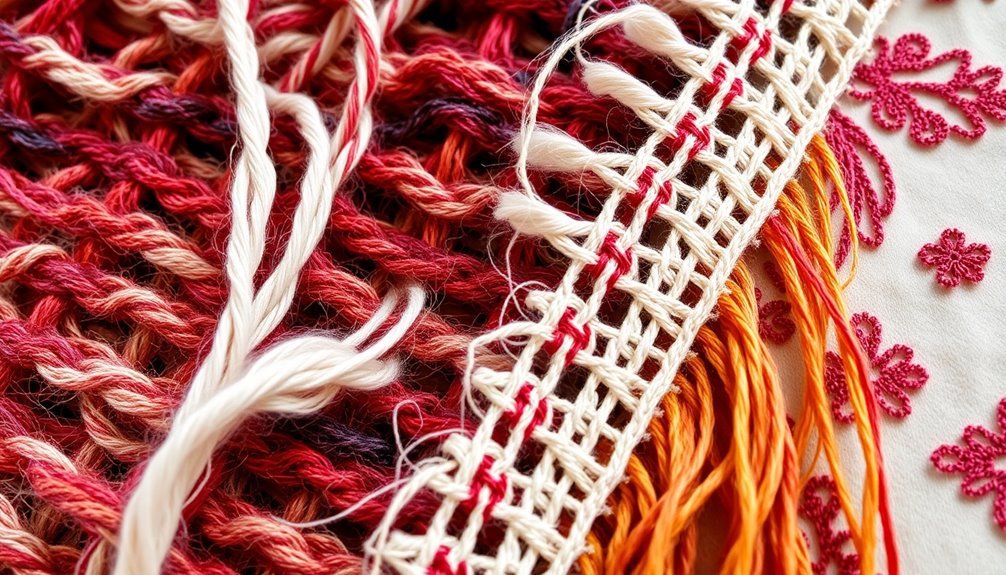
Materials play an essential role in weaving, affecting both the final product's texture and durability.
You'll find a rich variety of materials used in weaving, including:
- Natural fibers like cotton, wool, and silk
- Synthetic fibers such as polyester and nylon
- Yarn that varies in thickness and texture
- Specialty blends for unique fabric properties
Cotton is popular for its softness and versatility, perfect for clothing and home textiles.
Wool's insulating properties make it ideal for warm garments and blankets.
Silk adds a luxurious touch with its smoothness and sheen.
On the other hand, synthetic fibers like polyester provide durability and wrinkle resistance, making them suitable for various applications in creating fabric. Additionally, the choice of natural fibers can significantly influence the sustainability and environmental impact of the weaving process.
What Is Embroidery?
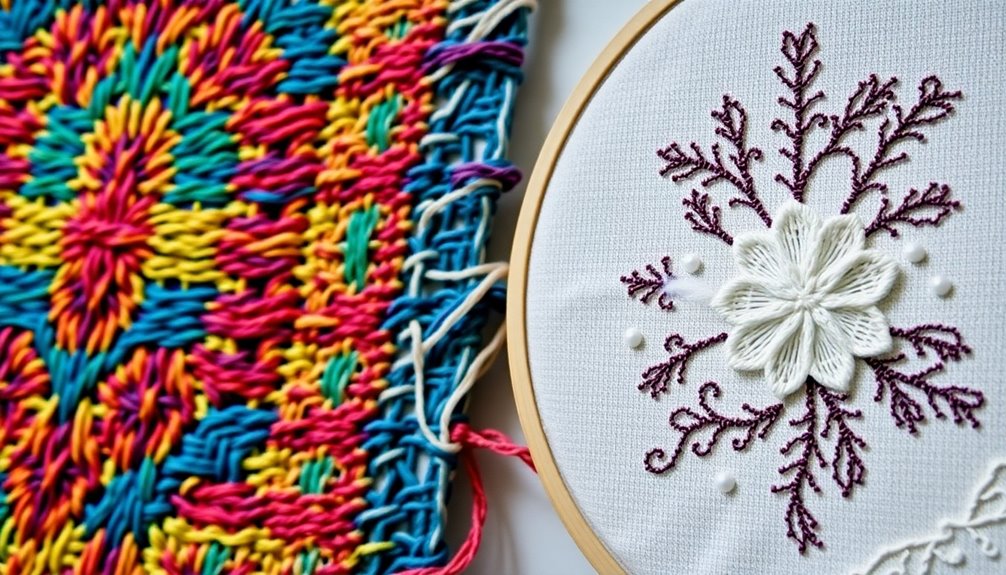
Embroidery is all about enhancing fabric through decorative stitching, and it's a skill that combines creativity with technique.
You can use various materials like beads and sequins to elevate your designs, while different stitches bring unique textures and effects.
This art form has a rich history, showcasing its significance across cultures in both clothing and decorative items.
Techniques of Embroidery
There are several techniques that can elevate fabric decoration to an art form, each offering unique textures and visual effects. You can explore various embroidery techniques that enhance plain fabrics with intricate designs.
Here are a few popular options:
- Backstitch: Creates strong, continuous lines.
- Satin stitch: Fills areas with smooth, shiny threads.
- Running stitch: Offers a simple, dashed line effect.
- Cross-stitch: Forms X-shaped stitching patterns for added depth.
Whether you choose hand embroidery or machine embroidery, each method allows for personal expression and the incorporation of decorative elements.
The versatility of these stitching patterns transforms everyday items into unique textile arts, showcasing your creativity and enhancing their visual appeal.
Materials Used in Embroidery
Choosing the right materials can greatly impact the outcome of your embroidery projects. You'll want to take into account various threads, fabrics, and tools to enhance your stitching techniques. Here's a quick overview of essential materials:
| Type | Description |
|---|---|
| Threads | Rayon for sheen, metallic for unique effects |
| Fabric | Cotton, linen, silk, and polyester options |
| Embellishments | Beads, sequins, and appliqué for texture |
| Tools | Hoops, needles, and stabilizers for support |
| Techniques | Various methods to create decorative designs |
Combining these materials effectively allows you to achieve stunning embroidered pieces. Don't underestimate the role of each item in your project; they all contribute to the final visual impact.
Historical Significance of Embroidery
For centuries, the art of embroidery has woven itself into the fabric of cultures worldwide, serving as a means of personal expression and societal representation.
- Embroidery showcases intricate patterns that convey stories and identities.
- It's an ancient art form with historical evidence tracing back to the Neolithic period.
- Various stitching methods, like cross-stitch and satin stitch, highlight its artistic value.
- Machine embroidery has revolutionized the craft, making it more accessible.
Traditionally, embroidery denoted status, with unique styles reflecting cultural heritage.
From decorative textiles to ceremonial items, it underscores its versatility.
Today, while machine embroidery allows for mass production, the charm of hand-stitched pieces remains revered, ensuring this timeless craft continues to thrive.
Embroidery Techniques
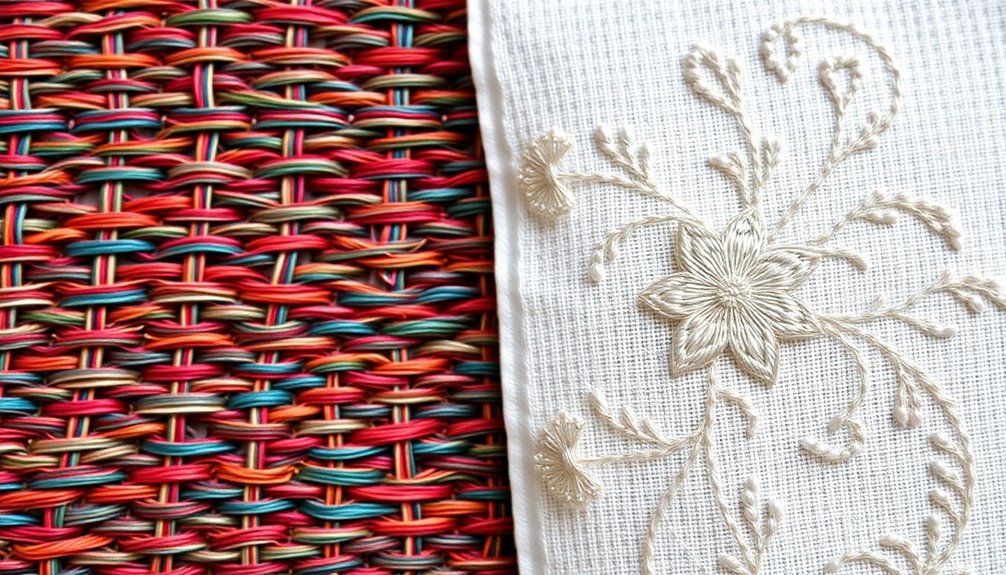
While exploring the world of embroidery techniques, you'll discover a rich variety of stitching methods that can transform simple fabrics into intricate works of art.
Techniques like backstitch, satin stitch, and cross-stitch offer unique visual effects and textures, enhancing your designs. Hand embroidery allows you to express your creativity, incorporating specialized stitches, beads, and sequins for added aesthetic appeal.
On the other hand, machine embroidery automates the process, enabling you to produce intricate designs quickly and consistently. The choice of thread plays an essential role too; selecting rayon for its sheen or cotton for durability can greatly impact the final look and tactile quality.
Materials Used in Embroidery
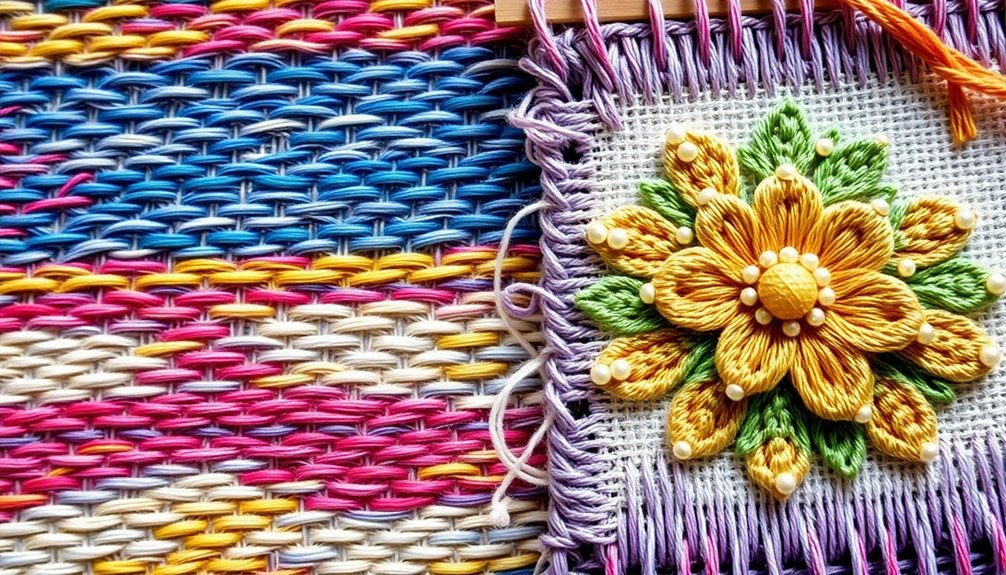
When it comes to embroidery, the type of thread you choose can make a big difference in the overall look.
You might love the sheen of rayon or the durability of cotton, but don't forget about adding extra flair with beads or sequins.
These embellishments can really elevate your designs and bring your creations to life.
Thread Types and Textures
Embroidery thrives on the variety of thread types and textures that artists choose to use, each contributing to the overall aesthetic and feel of the piece.
Here are some key elements to contemplate:
- Rayon: Offers a glossy finish, enhancing color vibrancy.
- Cotton: Known for its matte appearance and durability.
- Specialty Threads: Metallic and silk threads create unique textures and visual effects.
- Thickness Variation: Finer threads add delicate details, while thicker threads deliver a bold look.
The choice of thread types and textures greatly influences the final appearance and tactile quality of your embroidered piece, making it not just decorative but also a sensory experience.
Explore these options to elevate your woven fabric projects!
Additional Embellishing Materials
Adding embellishing materials to your embroidery can transform a simple design into a stunning work of art. These materials, like beads, sequins, pearls, and quills, enhance your projects by adding texture and creativity. They can be sewn into beautiful fabrics using specialized stitches, allowing for personalization in your designs.
| Embellishing Material | Effect |
|---|---|
| Beads | Shimmering effect |
| Sequins | Catch the light |
| Pearls | Elegant touch |
| Quills | Sophisticated flair |
Key Differences Between Weaving and Embroidery
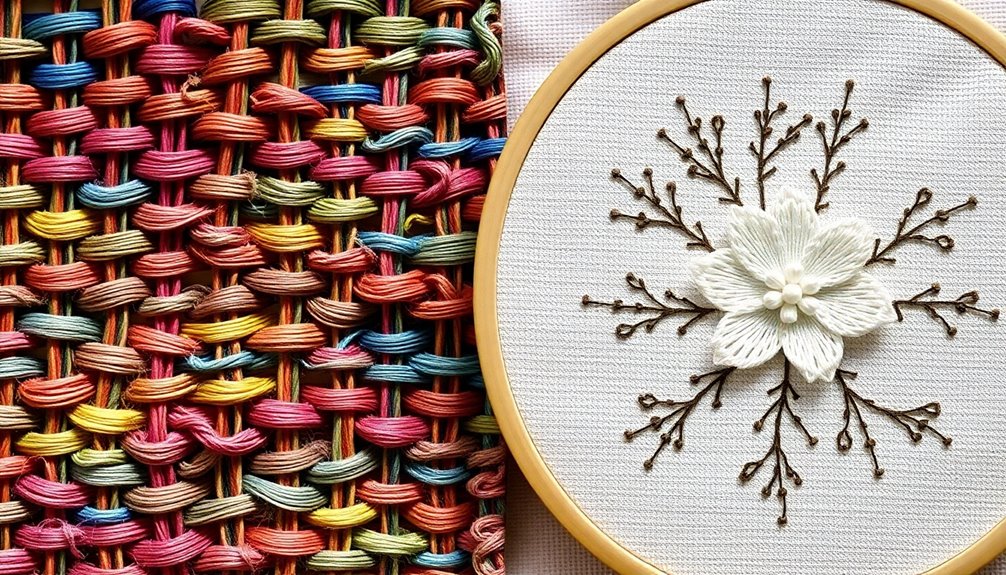
While both weaving and embroidery contribute to fabric artistry, they serve distinct purposes in the textile world. Here are some key differences between the two:
- Weaving creates fabric through the interlacing warp and weft threads.
- Embroidery involves decorating existing fabric with various stitches.
- Weaving focuses on the structural integrity of textiles, while embroidery emphasizes artistic detail.
- The techniques and tools for weaving include looms, while embroidery can be done by hand or machine.
In essence, weaving is the process of creating fabric, producing continuous lengths of distinct textile, while embroidery enhances the final products with decorative elements.
Understanding these key differences between weaving and embroidery highlights their unique roles in textile creation. Weaving typically involves interlacing threads at right angles to create a fabric, while embroidery embellishes that fabric with decorative stitches. This distinction not only defines their artistic contributions but also impacts the choice of materials and the overall texture of the final product. Additionally, exploring the broader context of textile arts reveals further contrasts, such as sewing techniques versus knitting methods, which provide additional layers of creativity and functionality in garment and textile design.
Practical Applications of Weaving and Embroidery
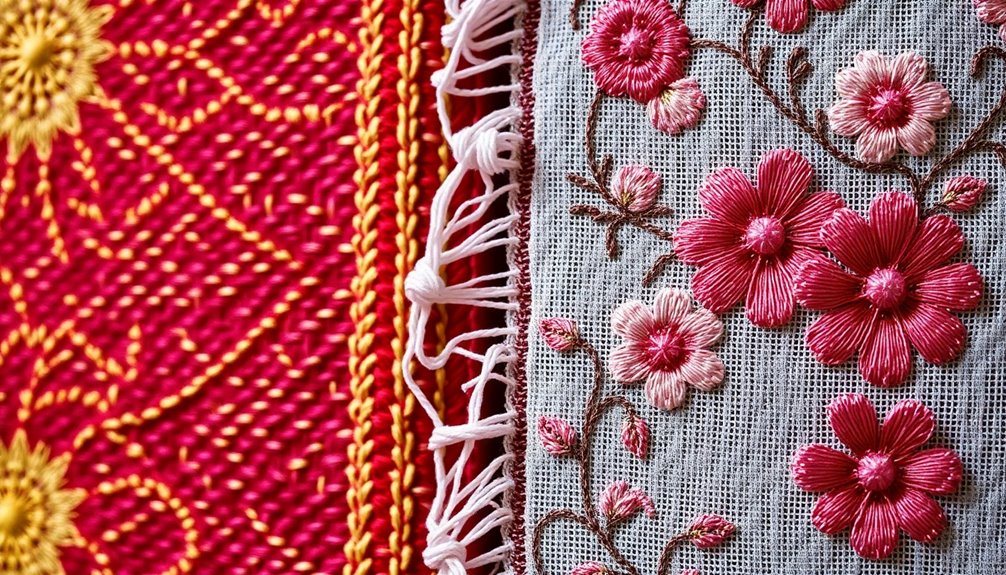
When you explore the practical applications of weaving and embroidery, you'll find that each technique plays a vital role in various industries.
Weaving is essential for fabric production, creating strong, functional fabrics for clothing, upholstery, and home textiles. Techniques like plain, satin, and twill weaves guarantee durability.
On the other hand, embroidery focuses on decorative enhancement, allowing you to personalize items with intricate patterns and designs. This technique elevates aesthetic appeal, making embroidered garments and accessories popular choices for custom gifts or promotional materials.
The combination of weaving and embroidery results in unique textile creations, such as woven garments adorned with embroidered embellishments, showcasing both functional fabric and artistic expression in the textile art forms you encounter daily.
Frequently Asked Questions
What Is the Main Difference Between Weaving and Embroidery?
The main difference between weaving and embroidery lies in their purpose and technique.
You create fabric through weaving by interlacing threads on a loom, focusing on structure. In contrast, you use embroidery to enhance existing fabric by stitching designs onto its surface.
While weaving produces cloth, embroidery adds decorative elements. Fundamentally, weaving is about making fabric, and embroidery is about beautifying it, each with its unique processes and materials.
What's the Difference Between Woven and Embroidery?
Think of woven and embroidered fabrics as two dancers with distinct styles.
Woven fabrics are created by interlacing threads to form a strong, flat material, while embroidery adds decorative stitches onto existing fabric, giving it depth and flair.
When you choose woven, you get lightweight and smooth designs. Opt for embroidery, and you'll enjoy intricate patterns bursting with texture.
Each technique serves a different purpose, so pick what best suits your vision!
What Is the Difference Between Weaving and Embroidery Quizlet?
When you look at the difference between weaving and embroidery on platforms like Quizlet, you'll see that weaving creates fabric through the interlacing of threads, while embroidery involves stitching designs onto that fabric.
You focus on how weaving produces the base material, and embroidery enhances it with decorative elements.
What Is the Difference Between Weaving and Embroidery Brainly?
When you ask about the difference between weaving and embroidery, it's important to recognize how each technique serves a unique purpose.
Weaving creates fabric by interlacing threads, while embroidery adds decorative designs onto that fabric.
You'll find that weaving focuses on the structure of the material, whereas embroidery enhances its visual appeal.
Each method uses different skills and tools, so knowing what you want to achieve helps you choose the right approach.
Conclusion
In weaving, you're like a spider crafting a web, intricately intertwining threads to create a strong foundation. On the other hand, embroidery is akin to painting on a canvas, where each stitch adds color and personality. Both arts bring fabric to life in unique ways, enhancing our world with creativity. Whether you're wrapping yourself in a woven blanket or admiring embroidered art, you're embracing the beauty of craftsmanship that connects us all through creativity and culture.
